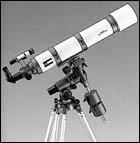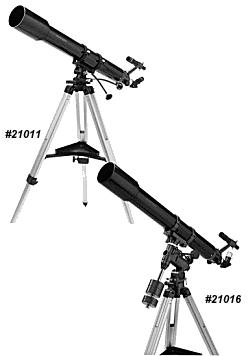Not All Telescopes Are Created Equal
Jack Kramer
Update: Since this article was first published, newer versions of these telescopes have been introduced. However, these models continue to be available in the used marketplace.
A Little over a year ago, both Meade and Celestron introduced new lower-priced models of 4-inch refractors with equatorial mountings. Both are listed for about $700, which is a very attractive price for an instrument of this type. I was curious how these scopes compare with each other, and how they stack up against more expensive 4-inch refractors. One way both Meade and Celestron have been able to lower their prices on these telescopes is to farm out the production to China or Taiwan.
The following is the advertising copy for Meade's Model 102ACHR/500 4-inch refractor, taken directly from the Meade web site.

A high-resolution instrument that, for many, is all the telescope ever required. High-performance refracting telescopes have long been regarded as the instruments of choice for the imaging of lunar and planetary detail. The Meade 102ACHR/500 fully lives up to these expectations, and is a magnificent instrument for the exploration of deep-space as well. The standard equipment Series 3000 Plössl 25mm (37X) eyepiece yields an actual field of view 1.35° in diameter (almost three Moon-diameters), ideal for scanning through the Summer Milky Way. Saturn's rings, including the Cassini Division; numerous cloud belts on Jupiter's surface; and shadow-transits of Jupiter's four main satellites as they cross the planet's disc are all within reach of the 102ACHR/500. Supplied with bronze worm gears on both axes; 1.25" focuser; 6 x 30mm viewfinder.
This particular Meade refractor is a product of Taiwan. The ad copy implies that the telescope could be used for imaging (i.e.: CCD or photography). However, reviews posted to the Internet indicate that the mounting does not operate smoothly and has an unacceptable level of backlash. More damaging was the following experience of a purchaser as recounted on the Scope Review web site http://www.scopereviews.com/
"This scope developed a rattle inside its lens cell. Upon further inspection, it was discovered that the lens elements were loose inside the cell. What's worse, the retaining ring was screwed down so tight that it couldn't be loosened, even by the dealer. The dealer contacted Meade, who promptly sent out a new OTA (Optical Tube Assembly). However, upon inspection of the new OTA, it too had rattling lenses inside its cell. Using the push-pull screws, the lens was aligned and re-tested. Unlike the original lens, this new one exhibits some spherical aberration. The objective shows up some rather extreme overcorrection. Again, Meade was contacted. They apologized for the poor OTA and agreed to send out a third unit right away. The third OTA arrived, and it too had loose lens elements, but it wasn't as bad as the other two. Unfortunately, this third tube had severe astigmatism, and was undercorrected by about 3/4 wave to boot. Add this to the chromatic aberration, and its images were unacceptable, even at low power. In many ways, this third OTA is the worst of all of them. Meade sent a fourth tube. This one, we had been told, had been personally inspected and used under dark skies by a Meade employee. It was one of the best examples of a 102ACHR/500 he had seen. The OTA arrived. It, too, had a rattling lens cell. The owner called Meade and shook the tube into the phone, so the rep could hear it. He told us to test it anyway, which we did. This fourth OTA shows only minor overcorrection, and no astigmatism. Also, it seemed to have somewhat less false color, as well. Optically, it is by far the best of the four units received. Had we wound up with this one to start with, we would have been very happy.
I don't know if it was dumb luck that we wound up with three questionable units in a row, or whether this experience is indicative of a larger-scale problem, but I would urge prospective buyers to use some caution before purchasing one of these."
Though Meade sells much state-of-the-art equipment at reasonable prices, there has been a long history of quality problems on certain items. There seems to be a love-hate relationship between Meade and its customers. When Meade products are good, they're very good; when they're bad they're horrible! Obviously, advertising hype and reality don't always jibe. As a general rule, it appears that items made in either Taiwan or China tend to suffer from inconsistent quality, even though the products are touted as being "manufactured to Meade's specifications". One of these specifications apparently is to cut corners to keep the cost as low as possible. Products that Meade manufactures in its own factories in the United States (such as the ETX series of small telescopes) seem to be of generally good quality.
Now on to Celestron, which has touted its new "HD" line of 4-inch refracting telescopes. Based on contact with three owners of HD models, plus info on the Scope Review web site, it appears that the quality of this telescope is much better than its rival from Meade. Be aware, however, that despite appearances or what Celestron may imply in some of its ads, this scope is neither better than nor the equal of the GP-C102 model that it supposedly replaced. (There is a close cousin of the GP-C102 still available from the Orion Telescope Center.) The following info is from Celestron's web site.

These telescopes are carefully designed for the more serious astronomer and terrestrial observer and feature exquisite optics and precision, heavy duty mounts. The optics of these telescopes are made to exacting standards, with high quality materials to ensure top performance. You'll find that astronomical viewing is a delight with these large, powerful 4" telescopes. They offer a 63% increase in image brightness over 80mm models, with the larger aperture delivering incredible images of: the moon; Saturn and its ring structure; Jupiter and its belts; and hundreds of deep-sky objects, including galaxies, nebulae and star clusters. The C102-HD is mounted on the CG-4 mount, a very rigid German equatorial mount. A counterweight, latitude scale, setting circles and slow motion controls on both axes are standard.
The price is a hint of what to expect - it's about half the cost of the old GP-C102. The new C102-HD optical tube assembly is made in China, whereas the GP-C102 was made in Japan by Vixen, a well-regarded optical firm. Product reviews indicate the HD optics are not quite on a par with those in Celestron's former line of refractors. A side-by-side comparison reveals that the tube of the HD scope has a smaller diameter than the old GP-C102; that's because the tube no longer has internal light baffles. Also, more parts are now made of plastic.
Celestron is also touting its new CG-4 mounting which recent ads claim is "upgraded and much better than the older Polaris mounts". I think if the marketing people at Celestron were backed into a corner, they'd have to admit that it's not really upgraded and that "much better" actually means "much less expensive". The mountings look identical; however, reviews indicate the CG-4 in fact does not operate as smoothly as the Vixen Super Polaris/Great Polaris mount it replaced and is not capable of handling as much weight. Also, it no longer comes with the standard polar axis finder or accessory mounting pads on the tube rings.
Despite the ravages of cost-cutting, the C102-HD is not a bad telescope. After covering it for the Scope Review web site, the reviewer, Ed Ting, ended up keeping it for his own use. That certainly is a recommendation right there. Here are his comments: "While I consider the C102-HD to be a good value, they are not as good as the old GP-C102 units. However, they do cost 50%, and that accounts for something. The older C102s have less false color, but the newer ones seem to have darker coatings. Also, the new Taiwanese mounts are nowhere near as good as the Super Polaris. Some of the C102-HDs have 1.25" focusers, while others (like mine) have 2" focusers. It does seem to be a matter of luck as to which version and quality level you get."
It appears that since being taken over by Tasco, Celestron's marketing rhetoric has been cranked up a bit. Contrary to what their ads say, this product line has been somewhat downgraded, no doubt in order to confront Meade head-on in the price wars. Moreover, the fact that Celestron no longer distributes an apochromatic version of its 4-inch refractor confirms that they have abandoned at least one part of the higher quality refractor market. Celestron makes some fine products, but perhaps it's well to be a little suspicious of their advertising hyperbole nowadays.
Ed Ting provided a summary of his experience with the new low-priced 4-inch refractors: "...even the worst C102-HDs I've seen are better than Meade's horrible 102ACHR/500. I have gotten letters from owners of that scope that are unprintable." It's also apparent that there may be differences in quality and components between telescopes of the same model. The best advice? Although we've looked at one particular type of telescope here, it's an example that applies to anything you decide to purchase. First, understand the capabilities and limitations of the equipment. Discount some of what you read in the advertisements; instead, seek out the experiences of actual users or unbiased product reviews. Then be sure to deal with a reputable supplier who will make good on any unsatisfactory product. If you can't find anyone else who has knowledge about the telescope, ask the dealer for his opinion. They won't recommend a product that's likely to generate returns from dissatisfied customers.





